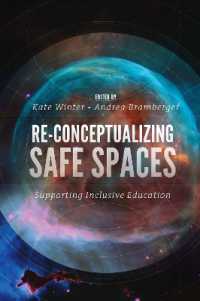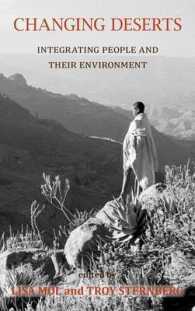Full Description
It is now over 50 years since the term 'gentrification' was first coined by the British urbanist Ruth Glass in 1964, in which time gentrification studies has become a subject in its own right. This Handbook, the first ever in gentrification studies, is a critical and authoritative assessment of the field. Although the Handbook does not seek to rehearse the classic literature on gentrification from the 1970s to the 1990s in detail, it is referred to in the new assessments of the field gathered in this volume. The original chapters offer an important dialogue between existing theory and new conceptualisations of gentrification for new times and new places, in many cases offering novel empirical evidence.
Scholarly contributions are drawn from both established and up and coming experts in gentrification studies world-wide, and a deliberate attempt has been made to broaden the geographical scope of study. As such, the Handbook covers processes of gentrification in the global north and the global south. It also looks at different mutations of gentrification and pays proper attention to both resistance to gentrification and the importance of thinking about alternatives. The Handbook challenges readers to look at both the future of gentrification studies as well as the actual process of gentrification itself.
Gentrification studies is interdisciplinary and this Handbook will be especially useful to scholars in many fields including geography, sociology, anthropology, planning, law, urban studies, policy studies, rural studies, development studies, and cultural studies. It will also be of value to those activists fighting gentrification worldwide.
Contents
CONTENTS
INTRODUCTION
1. Towards a C21st Global Gentrification Studies
Loretta Lees
SECTION I RETHINKING GENTRIFICATION (THEORY)
2. Beyond Anglo-American Gentrification Theory
Hyun Bang Shin and Ernesto López-Morales
3. Beyond the Elephant of Gentrification: relational approaches to a chaotic problem
Freek de Hann
4. Comparative urbanism in gentrification studies: fashion or progress?
Loretta Lees
SECTION II KEY/CORE CONCEPTS IN GENTRIFICATION STUDIES
5. From class to gentrification and back again
Michaela Benson and Emma Jackson
6. Gentrification and Landscape Change
Martin Phillips
7. Spatial capital and planetary gentrification: residential location, mobility and social inequality
Patrick Rérat
8. Rent gaps
Tom Slater
9. Gentrification-induced Displacement
Zhao Zhang and Shenjing He
SECTION III SOCIAL CLEAVAGES IN ADDITION TO CLASS
10. Non-normative sexualities and gentrification
Petra Doan
11. Age, lifecourse and generation in gentrification processes
Cody Hochstenbach and Willem Boterman
12. Gentrification and ethnicity
Tone Huse
13. Rethinking the Gender-Gentrification Nexus
Bahar Sakizlioglu
SECTION IV TYPES OF GENTRIFICATION
14. Slum gentrification
Eduardo Ascensão
15. New-build gentrification
Mark Davidson
16. The Gentrification of Public Housing
Melissa Fernández Arrigoitia
17. Tourism Gentrification
Agustin Cocola-Gant
18. Retail Gentrification
Phil Hubbard
19. Gentle gentrification in the exceptional city of LA?
Juliet Kahne
20. New directions in urban environmental/green gentrification research
Hamil Pearsall
21. Gentrification, artists and cultural economy
Andy Pratt
22. Wilderness gentrification: moving 'off-the-beaten rural tracks'
Darren Smith, Martin Phillips and Chloe Kinton
SECTION V LIVING AND RESISTING GENTRIFICATION
23. Resisting gentrification
Sandra Annunziata and Clara Rivas-Alonso
24. Alternatives to gentrification: exploring urban community land trusts and urban ecovillage practices
Susannah Bunce
25. Immigration and gentrification
Geoffrey DeVerteuil
26. Property and planning law in England: facilitating and countering gentrification
Antonia Layard
27. Self renovating neighbourhoods as an alternative to gentrification or decline
Jess Steele
Index








